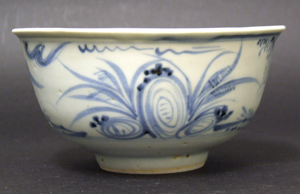
CHONGZHEN 1628-1644 or SHUNZHI 1644-1661. Transitional Porcelain.
A Small Transitional Blue and White Porcelain Dish, Late Chongzhen or Early Shunzhi c.1640-1650. The Shallow Flower Shaped Form Painted with a Horse and Flowers Among Swirling Waters and Crashing Waves. The Base with an Apocryphal Ming, Jiajing (1522-1566) Mark.
SOLD
- Condition
- Very minor fritting.
- Size
- Diameter : 8.6 cm ( 3 1/3 inches).
- Provenance
- N/A
- Stock number
- 21226
Information
Apocryphal marks are frequently encountered on Chinese porcelain particularly on Kangxi Blue and White Porcelain, the mark of the Ming Emperor Chenghua who reigned from 1465 to 1487 being by far the most common, other Ming marks include Jiajing (1522-1566) and less frequently Wanli (1573-1620). These marks were not added to the piece to deceive, but more as a sign of reverence to earlier potters of the Ming dynasty (1368-1644). Occasionally they are used on pieces copying Ming Porcelain, these objects were probably made for collectors who could not afford the Ming original. Tianqi is an early period for such an apocryphal mark.
Dishes of the design were recovered from the Hatcher Cargo of c.1643. See a pair of Hatcher cargo dishes of this pattern from the John Drew Collection, stock 19489 in our Archive.
For a large Transitional Blue and White Porcelain dish of this pattern see 20678 in our Archive.
For an important blue and white Transitional Porcelain dish dated 1645 of this shape with waves and flower heads in the Percival David Collection at the British Museum, London see : Oriental Blue and White (Sir Harry Garner, Faber and Faber,1954. ISBN 571-04702-5) page 41 plate 64A.



